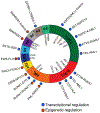Fusion genes as biomarkers in pediatric cancers: A review of the current state and applicability in diagnostics and personalized therapy
- PMID: 33248210
- PMCID: PMC9275405
- DOI: 10.1016/j.canlet.2020.11.015
Fusion genes as biomarkers in pediatric cancers: A review of the current state and applicability in diagnostics and personalized therapy
Abstract
The incidence of pediatric cancers is rising steadily across the world, along with the challenges in understanding the molecular mechanisms and devising effective therapeutic strategies. Pediatric cancers are presented with diverse molecular characteristics and more distinct subtypes when compared to adult cancers. Recent studies on the genomic landscape of pediatric cancers using next-generation sequencing (NGS) approaches have redefined this field by providing better subtype characterization and novel actionable targets. Since early identification and personalized treatment strategies influence therapeutic outcomes, survival, and quality of life in pediatric cancer patients, the quest for actionable biomarkers is of great value in this field. Fusion genes that are prevalent and recurrent in several pediatric cancers are ideally suited in this context due to their disease-specific occurrence. In this review, we explore the current status of fusion genes in pediatric cancer subtypes and their use as biomarkers for diagnosis and personalized therapy. We discuss the technological advancements made in recent years in NGS sequencing and their impact on fusion detection algorithms that have revolutionized this field. Finally, we also discuss the advantages of pairing liquid biopsy protocols for fusion detection and their eventual use in diagnosis and treatment monitoring.
Keywords: Fusion genes; Next-generation sequencing; Pediatric cancer; ctDNA.
Copyright © 2020. Published by Elsevier B.V.
Figures



Similar articles
-
Cell-free circulating tumor DNA supplementing tissue biopsies for identification of targetable mutations: Implications for precision medicine and considerations for reconciling results.Lung Cancer. 2017 Sep;111:135-138. doi: 10.1016/j.lungcan.2017.06.015. Epub 2017 Jun 23. Lung Cancer. 2017. PMID: 28838384
-
Circulating tumor DNA: a promising biomarker in the liquid biopsy of cancer.Oncotarget. 2016 Jul 26;7(30):48832-48841. doi: 10.18632/oncotarget.9453. Oncotarget. 2016. PMID: 27223063 Free PMC article. Review.
-
Circulating tumor DNA-From bench to bedside.Curr Probl Cancer. 2017 May-Jun;41(3):212-221. doi: 10.1016/j.currproblcancer.2017.02.005. Epub 2017 Mar 1. Curr Probl Cancer. 2017. PMID: 28416241
-
Liquid Biopsy in the Clinical Management of Cancers.Int J Mol Sci. 2024 Aug 6;25(16):8594. doi: 10.3390/ijms25168594. Int J Mol Sci. 2024. PMID: 39201281 Free PMC article. Review.
-
Detection of Circulating Tumor DNA in Lymphoma Patients.Methods Mol Biol. 2025;2865:475-490. doi: 10.1007/978-1-0716-4188-0_21. Methods Mol Biol. 2025. PMID: 39424738
Cited by
-
Clinical implementation of plasma cell-free circulating tumor DNA quantification by digital droplet PCR for the monitoring of Ewing sarcoma in children and adolescents.Front Pediatr. 2022 Aug 15;10:926405. doi: 10.3389/fped.2022.926405. eCollection 2022. Front Pediatr. 2022. PMID: 36046479 Free PMC article.
-
Drugging Hijacked Kinase Pathways in Pediatric Oncology: Opportunities and Current Scenario.Pharmaceutics. 2023 Feb 16;15(2):664. doi: 10.3390/pharmaceutics15020664. Pharmaceutics. 2023. PMID: 36839989 Free PMC article. Review.
-
A comprehensive overview of liquid biopsy applications in pediatric solid tumors.NPJ Precis Oncol. 2024 Aug 3;8(1):172. doi: 10.1038/s41698-024-00657-z. NPJ Precis Oncol. 2024. PMID: 39097671 Free PMC article. Review.
-
Biological and therapeutic insights from animal modeling of fusion-driven pediatric soft tissue sarcomas.Dis Model Mech. 2024 Jun 1;17(6):dmm050704. doi: 10.1242/dmm.050704. Epub 2024 Jun 25. Dis Model Mech. 2024. PMID: 38916046 Free PMC article. Review.
-
Identification of Hub Genes Correlated With Poor Prognosis for Patients With Uterine Corpus Endometrial Carcinoma by Integrated Bioinformatics Analysis and Experimental Validation.Front Oncol. 2021 Nov 19;11:766947. doi: 10.3389/fonc.2021.766947. eCollection 2021. Front Oncol. 2021. PMID: 34868993 Free PMC article.
References
Publication types
MeSH terms
Substances
Grants and funding
LinkOut - more resources
Full Text Sources
Other Literature Sources
Medical

